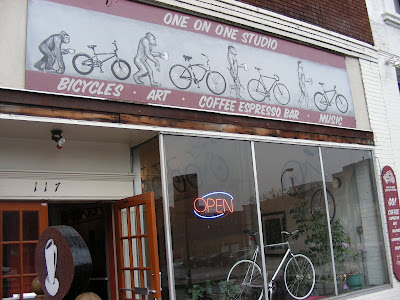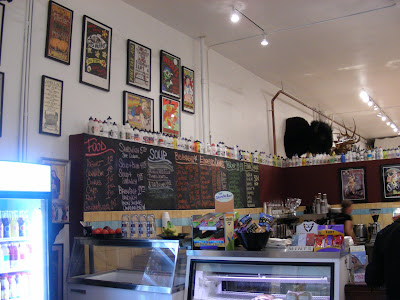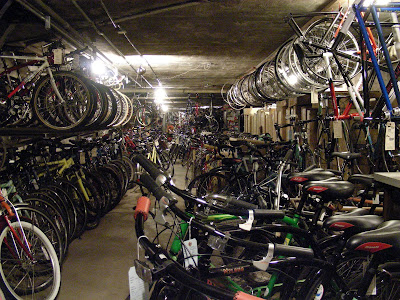 Inevitably, when the cycling discussion turns to which shops "do it right," One on One Studio is always mentioned. For years, I've heard about the magic going down in Minnesota and often the buzz is hitched to One on One (OoO). If you were a mountain biker in the late 80s or early 90s, then you have heard of the shop's founder, Gene Oberpriller. Gene is as much a part of early mountain bikes as Tioga's tension disk and Suntour XC PRO. Through his years in the sport, the industry, and the city of Minneapolis, Gene understands his clientele and the local cycling scene. In a word, Gene gets the importance of creating a community environment. With so much talk about the bike scene in Minneapolis, it was time for BKW to hit the road again, this time in an effort to get some One on One time.
Inevitably, when the cycling discussion turns to which shops "do it right," One on One Studio is always mentioned. For years, I've heard about the magic going down in Minnesota and often the buzz is hitched to One on One (OoO). If you were a mountain biker in the late 80s or early 90s, then you have heard of the shop's founder, Gene Oberpriller. Gene is as much a part of early mountain bikes as Tioga's tension disk and Suntour XC PRO. Through his years in the sport, the industry, and the city of Minneapolis, Gene understands his clientele and the local cycling scene. In a word, Gene gets the importance of creating a community environment. With so much talk about the bike scene in Minneapolis, it was time for BKW to hit the road again, this time in an effort to get some One on One time.As I stepped foot into the shop, I was greeted by the creak of the worn wooden floors and the growl of an espresso machine's milk steamer. To my right sat a row of tables and a couple sharing a bowl of soup. Upon first glance, I had to wonder: Where are the bikes?
The shop is divided into three distinct areas: the coffee and sandwich bar, the studio, and the service area. Each section acts as a stand-alone space. As I passed through the sweet aroma of the daily brew and then through the bike inventory, I landed in the service area that buzzed with activity. To my right, running the full length of the space, rested every incarnation of Bianchi's single speed MTB and to my left, was a wall of printed memorabilia and current events. Upon my arrival in the service area, new inventory was being diligently entered into the database and repairs were underway.

One on One is a curious mix of coffee shop, bike shop, ecelctic art gallery, and junkyard; a bit of a museum of useful things, if you will. In many ways, One on One is the bike room that you dream of and, to a cyclist who loves Bridgestone and its history, this shop just can't be missed. Herein lies the evidence that Gene knows a thing or two about what makes a cyclist tick: sweet machines, all the tools you could imagine, never-a-bad-cuppa espresso machine, cool art, and all the keepsakes from your years of racing. What more could a cyclist want?
A walk through OoO:
When I first entered the door, I turned around and resting above the front door is Gene's orange X0-1 from '93, the very bike Gene rode to victory at the famous Chequamegon 40. This piece of history remains outfitted with all the bells and whistles from the era: a Softride suspension stem, Shimano 737 SPDs, moustache bars, and even an orange Silca frame pump. For a rainy October day, the shop was alive with the sights and sounds of a traditional bike shop.
Light Fare
The first third of the shop is a fully functioning coffee house, complete with artwork and a menu of delicious items. The coffee is excellent, the treats fresh, and the soup is good enough that you'd be proud to call it your own. Sandwiches round out the menu and prove that One on One is good for more than replacing a broken spoke.

The Studio
Gene's studio portion of the shop displays bicycles as the works of art that they are. Featured on waterfall type racks, each model is represented only once. Here, there's no "big box" approach where the inventory is spilling out of every nook. Whenever I visit a shop where the bike display emphasizes the bicycle itself, I'm reminded of how beautifully simple the bicycle is, and how it's certainly worthy of the prime space above your fireplace. The "studio" feel of Gene's shop is the idyllic backdrop for the aesthetic beauty of a Bianchi, and whether it's the pedigree of their high-end road machines or the smooth swoop of the Bergamo's handle bars, One on One provides the right canvas for these masterpieces.

Service
The service area is located in the rear of the building, which provides those seeking service with a direct alley entrance. This area was the gem of my entire experience and I spent the majority of my time closely eyeing it's very facets: cabinets housing both old and new bike components and frames, CD collections, historic machines, and a selection of handlebars that would make a stem rattle with excitement. Among the treasures I uncovered was an old velvet lamp, a fallback to the edifice's previous life as a sizzling "massage parlor".

The Basement
Words can not do justice to describe Gene's basement. Floor to ceiling. Wall to wall. Get yourself to Minneapolis and see it for yourself.

One on One Studio is an unparalleled and unprecedented shop for the cyclist who relies on his machine for transportation, livelihood, or just plain 'ol mental wellness. With all the cycling-centric activities offered in Minneapolis, it would be easy to time your visit to catch a handful of memorable cycling events both on and off the bike, year 'round.
One on One Studio
117 Washington Ave N. - Warehouse District
Minneapolis, MN 55401
Phone: 612.371.9565










